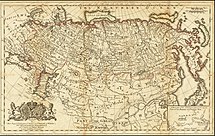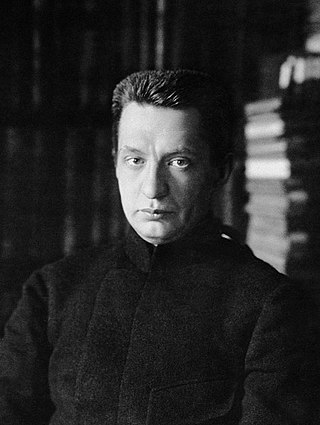
Alexander Fyodorovich Kerensky was a Russian lawyer and revolutionary who led the Russian Provisional Government and the short-lived Russian Republic for three months from late July to early November 1917 (N.S.)

Lavr Georgiyevich Kornilov was a Russian military intelligence officer, explorer, and general in the Imperial Russian Army during World War I and the ensuing Russian Civil War. Kornilov was of Siberian Cossack origin. Today he is best remembered for the Kornilov Affair, an unsuccessful endeavor in August/September 1917 that was intended to strengthen Alexander Kerensky's Provisional Government, but which led to Kerensky eventually having Kornilov arrested and charged with attempting a coup d'état, and ultimately undermined Kerensky's rule.

The October Revolution, also known as the Great October Socialist Revolution, October coup, or Bolshevik coup was a revolution in Russia led by the Bolshevik Party of Vladimir Lenin that was a key moment in the larger Russian Revolution of 1917–1923. It was the second revolutionary change of government in Russia in 1917. It took place through an armed insurrection in Petrograd on 7 November 1917 [O.S. 25 October]. It was the precipitating event of the Russian Civil War.
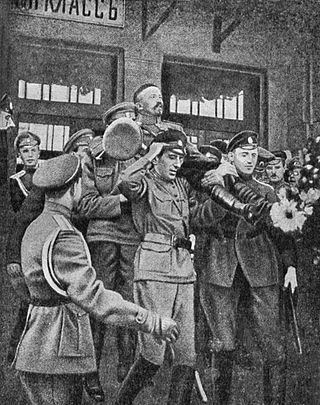
The Kornilov affair, or the Kornilov putsch, was an attempted military coup d'état by the commander-in-chief of the Russian Army, General Lavr Kornilov, from 10 to 13 September 1917, against the Russian Provisional Government headed by Aleksander Kerensky and the Petrograd Soviet of Soldiers' and Workers' Deputies. The exact details and motivations of the Kornilov affair are unconfirmed due to the general confusion of all parties involved. Many historians have had to piece together varied historical accounts as a result.

Pavel Nikolayevich Milyukov was a Russian historian and liberal politician. Milyukov was the founder, leader, and the most prominent member of the Constitutional Democratic party. He changed his view on the monarchy between 1905 and 1917. In the Russian Provisional Government, he served as Foreign Minister, working to prevent Russia's exit from the First World War.
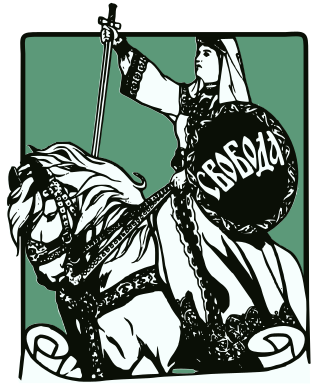
The Constitutional Democratic Party, also called Constitutional Democrats and formally the Party of People's Freedom, was a political party in the Russian Empire that promoted Western constitutional monarchy—among other policies—and attracted a base ranging from moderate conservatives to mild socialists. Party members were called Kadets from the abbreviation K-D of the party name. Konstantin Kavelin's and Boris Chicherin's writings formed the theoretical basis of the party's platform. Historian Pavel Miliukov was the party's leader throughout its existence.

The Kuban People's Republic or Kuban National Republic was an anti-Bolshevik state during the Russian Civil War, comprising the territory of the Kuban region in Russia.

The Crimean People's Republic or Crimean Democratic Republic was a self-declared state that existed from December 1917 to January 1918 in the Crimean Peninsula. The Republic was one of many short-lived states that declared independence following the 1917 Russian Revolution caused the collapse of the Russian Empire. The Crimean People's Republic was the First Turkic and Muslim Democratic Republic in the World.

The Russian Soviet Federative Socialist Republic, previously known as the Russian Soviet Republic and the Russian Socialist Federative Soviet Republic, as well as being unofficially referred to as Soviet Russia, the Russian Federation, or simply Russia, was an independent federal socialist state from 1917 to 1922, and afterwards the largest and most populous constituent republic of the Soviet Union (USSR) from 1922 to 1991, until becoming a sovereign part of the Soviet Union with priority of Russian laws over Union-level legislation in 1990 and 1991, the last two years of the existence of the USSR. The Russian SFSR was composed of sixteen smaller constituent units of autonomous republics, five autonomous oblasts, ten autonomous okrugs, six krais and forty oblasts. Russians formed the largest ethnic group. The capital of the Russian SFSR and the USSR as a whole was Moscow and the other major urban centers included Leningrad, Stalingrad, Novosibirsk, Sverdlovsk, Gorky and Kuybyshev. It was the first socialist state in the world.

The Decree on the system of government of Russia was a basis of the new constitution declared in 1918 in Russia during the Russian Revolution of 1917, during the five-month interregnum between the downfall of the Alexander Kerensky government and the official declaration of the Russian Socialist Federative Soviet Republic. It was formally declared on 18 January 1918 when the democratically elected Russian Constituent Assembly drafted and adopted the "Resolution on the form of government of Russia", declaring Russia to be a democratic federal republic called the "Russian Democratic Federative Republic". However, the Assembly was dissolved on the same day by the Bolshevik-controlled All-Russian Central Executive Committee, meaning the declaration was not carried out as it was considered to be without legal force.

The Ukrainian People's Republic of Soviets was a short-lived (1917–1918) Soviet republic of the Russian SFSR that was created by the declaration of the Kharkiv All-Ukrainian Congress of Soviets "About the self-determination of Ukraine" on 25 December [O.S. 12 December] 1917 in the Noble Assembly building in Kharkov. Headed by the Provisional Workers' and Peasants' Government of Ukraine formed earlier in Russian Kursk. The republic was later united into the Ukrainian Soviet Republic and, eventually, liquidated, because of a cessation of support from the government of the Russian SFSR when the Treaty of Brest-Litovsk was signed.

Universals of the Central Council of Ukraine are legal acts or declarations issued by the Central Council of Ukraine in 1917-18. These documents marked the main stages of the development of the nascent Ukrainian state, from the proclamation of its autonomy to the declaration of full independence.

The Russian Provisional Government was a provisional government of the Russian Empire and Russian Republic, announced two days before and established immediately after the abdication of Nicholas II. The intention of the provisional government was the organization of elections to the Russian Constituent Assembly and its convention. The provisional government, led first by Prince Georgy Lvov and then by Alexander Kerensky, lasted approximately eight months, and ceased to exist when the Bolsheviks gained power in the October Revolution in October [November, N.S.] 1917.
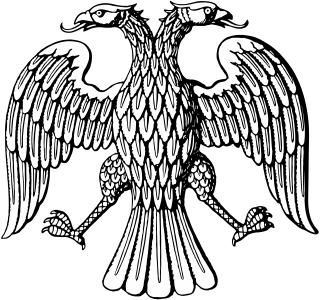
The All Russian Constituent Assembly was a constituent assembly convened in Russia after the February Revolution of 1917. It met for 13 hours, from 4 p.m. to 5 a.m., 18–19 January [O.S. 5–6 January] 1918, whereupon it was dissolved by the Bolshevik-led All-Russian Central Executive Committee, proclaiming the Third All-Russian Congress of Soviets the new governing body of Russia.
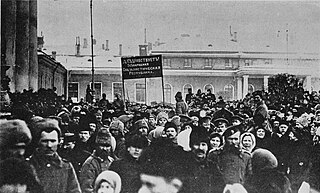
The February Revolution, known in Soviet historiography as the February Bourgeois Democratic Revolution and sometimes as the March Revolution, was the first of two revolutions which took place in Russia in 1917.
Events from the year 1917 in Russia.

An index of articles related to the Russian Revolution and the Russian Civil War period (1905–1922). It covers articles on topics, events, and persons related to the revolutionary era, from the 1905 Russian Revolution until the end of the Russian Civil War. The See also section includes other lists related to Revolutionary Russia and the Soviet Union, including an index of articles about the Soviet Union (1922–1991) which is the next article in this series, and Bibliography of the Russian Revolution and Civil War.

The Stavka of the Supreme Commander was the supreme headquarters of the Russian Imperial Army in the field during World War I until the demobilization of the army in March 1918.
The Establishment of Soviet power in Russia was the process of establishing Soviet power throughout the territory of the former Russian Empire, with the exception of areas occupied by the troops of the Central Powers, following the seizure of power in Petrograd on October 25, 1917, and in mostly completed by the beginning of the German offensive along the entire front on February 18, 1918.

